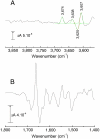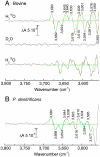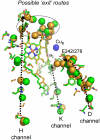Water molecule reorganization in cytochrome c oxidase revealed by FTIR spectroscopy
- PMID: 21543712
- PMCID: PMC3102355
- DOI: 10.1073/pnas.1019419108
Water molecule reorganization in cytochrome c oxidase revealed by FTIR spectroscopy
Abstract
Although internal electron transfer and oxygen reduction chemistry in cytochrome c oxidase are fairly well understood, the associated groups and pathways that couple these processes to gated proton translocation across the membrane remain unclear. Several possible pathways have been identified from crystallographic structural models; these involve hydrophilic residues in combination with structured waters that might reorganize to form transient proton transfer pathways during the catalytic cycle. To date, however, comparisons of atomic structures of different oxidases in different redox or ligation states have not provided a consistent answer as to which pathways are operative or the details of their dynamic changes during catalysis. In order to provide an experimental means to address this issue, FTIR spectroscopy in the 3,560-3,800 cm(-1) range has been used to detect weakly H-bonded water molecules in bovine cytochrome c oxidase that might change during catalysis. Full redox spectra exhibited at least four signals at 3,674(+), 3,638(+), 3,620(-), and 3,607(+) cm(-1). A more complex set of signals was observed in spectra of photolysis of the ferrous-CO compound, a reaction that mimics the catalytic oxygen binding step, and their D(2)O and H(2)(18)O sensitivities confirmed that they arose from water molecule rearrangements. Fitting with Gaussian components indicated the involvement of up to eight waters in the photolysis transition. Similar signals were also observed in photolysis spectra of the ferrous-CO compound of bacterial CcO from Paracoccus denitrificans. Such water changes are discussed in relation to roles in hydrophilic channels and proton/electron coupling mechanism.
Conflict of interest statement
The authors declare no conflict of interest.
Figures



Similar articles
-
ATR-FTIR spectroscopy of the P(M) and F intermediates of bovine and Paracoccus denitrificans cytochrome c oxidase.Biochemistry. 2003 Jul 29;42(29):8809-17. doi: 10.1021/bi034522d. Biochemistry. 2003. PMID: 12873142
-
Spectroscopic and kinetic investigation of the fully reduced and mixed valence states of ba3-cytochrome c oxidase from Thermus thermophilus: a Fourier transform infrared (FTIR) and time-resolved step-scan FTIR study.J Biol Chem. 2012 Oct 26;287(44):37495-507. doi: 10.1074/jbc.M112.403600. Epub 2012 Aug 27. J Biol Chem. 2012. PMID: 22927441 Free PMC article.
-
Comparison of redox and ligand binding behaviour of yeast and bovine cytochrome c oxidases using FTIR spectroscopy.Biochim Biophys Acta Bioenerg. 2018 Sep;1859(9):705-711. doi: 10.1016/j.bbabio.2018.05.018. Epub 2018 May 28. Biochim Biophys Acta Bioenerg. 2018. PMID: 29852141 Free PMC article.
-
FTIR studies of internal proton transfer reactions linked to inter-heme electron transfer in bovine cytochrome c oxidase.Biochim Biophys Acta. 2004 Apr 12;1655(1-3):321-31. doi: 10.1016/j.bbabio.2004.01.007. Biochim Biophys Acta. 2004. PMID: 15100047 Review.
-
Time-resolved optical absorption studies of cytochrome oxidase dynamics.Biochim Biophys Acta. 2004 Apr 12;1655(1-3):263-73. doi: 10.1016/j.bbabio.2003.07.011. Biochim Biophys Acta. 2004. PMID: 15100041 Review.
Cited by
-
Detection of a protein-bound water vibration of halorhodopsin in aqueous solution.Biophysics (Nagoya-shi). 2013 Dec 21;9:167-72. doi: 10.2142/biophysics.9.167. eCollection 2013. Biophysics (Nagoya-shi). 2013. PMID: 27493555 Free PMC article.
-
Insights into the mechanism of proton transport in cytochrome c oxidase.J Am Chem Soc. 2012 Jan 18;134(2):1147-52. doi: 10.1021/ja209176e. Epub 2012 Jan 6. J Am Chem Soc. 2012. PMID: 22191804 Free PMC article.
-
Synchrotron X-ray footprinting as a method to visualize water in proteins.J Synchrotron Radiat. 2016 Sep 1;23(Pt 5):1056-69. doi: 10.1107/S1600577516009024. Epub 2016 Jul 27. J Synchrotron Radiat. 2016. PMID: 27577756 Free PMC article.
-
Functions of the hydrophilic channels in protonmotive cytochrome c oxidase.J R Soc Interface. 2013 Jul 17;10(86):20130183. doi: 10.1098/rsif.2013.0183. Print 2013 Sep 6. J R Soc Interface. 2013. PMID: 23864498 Free PMC article. Review.
-
Oxygen Activation and Energy Conservation by Cytochrome c Oxidase.Chem Rev. 2018 Mar 14;118(5):2469-2490. doi: 10.1021/acs.chemrev.7b00664. Epub 2018 Jan 19. Chem Rev. 2018. PMID: 29350917 Free PMC article. Review.
References
-
- Rich PR, Maréchal A. The mitochondrial respiratory chain. Essays Biochem. 2010;27:1–23. - PubMed
-
- Kaila VRI, Verkhovsky MI, Wikström M. Proton-coupled electron transfer in cytochrome oxidase. Chem Rev. 2010;110:7062–7081. - PubMed
-
- Tsukihara T, et al. The whole structure of the 13-subunit oxidized cytochrome c oxidase at 2.8 Å. Science. 1996;272:1136–1144. - PubMed
-
- Iwata S, Ostermeier C, Ludwig B, Michel H. Structure at 2.8 Å resolution of cytochrome c oxidase from Paracoccus denitrificans. Nature. 1995;376:660–669. - PubMed
Publication types
MeSH terms
Substances
Grants and funding
LinkOut - more resources
Full Text Sources

